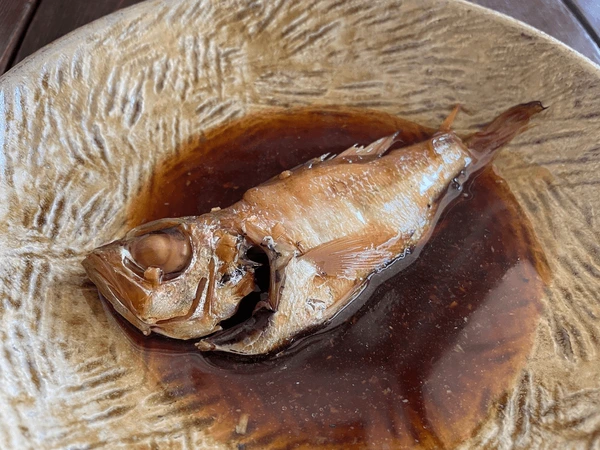Black throat sea perch – Habitat, prey and the origins of its names - Nodoguro, Akamutsu, geumtae


Origins of the name of the Black throat sea perch
The Black throat sea perch is also known as the rosy sea bass in English. The black throat sea perch’s academic scientific name is Doederleinia berycoides as it was named after the German zoologist Ludwig Döderlein.
The general name rosy sea bass comes from its red, rosy color on its scales while the name black throat sea perch comes from the black colored visceral membranes.




Black throat sea perch’s name in Japanese – Nodoguro(Nodokuro) Akamutsu
アカムツ(ノドグロ)すし 、 赤鯥(喉黒)寿司 The Japanese term mutsu (むつ) derives from mutsukkoi (むつっこい) a Tokuushima dialect that means “oily” or “strong flavor).
The term aka (赤) means red so the name akamutsu of the black throat sea perch means a red fish with oily and strong flavor in Japanese.
Also Nodoguro or Nodokuro (喉黒) means ‘throat black’ where nodo means throat in Japanese and kuro means black in Japanese.


Black throat sea perch’s name in Korean – 눈볼대(noonboldae), 금태(geumtae)
The standard Korean name for the black throat sea perch is 눈볼대, noonboldae which means it is a type of a eye with big eyes. The more common generic name for the black throat sea perch is 금태 guemtae which means a fish with a golden shape.
It is also called a red fish in some markets but as there are many types of fish called red fish, it is recommended to use the term 눈볼대(noonboldae) or 금태(geumate)



Habitats of black throat sea perches
Black throat sea perches inhabit deep oceans in the depths of 100m ~ 600 m about 327 feet to 2000 feet.
Black throat sea perches are found from Japan, South Korea, China, Taiwan to the east of the southeast Asia and even Australia.



Black throat sea perch’s prey
Black throat sea perches are carnivorous fish unlike their petit size and they feed on smaller fish, crustaceans such as crabs and shrimp.
They even feed on small squids and other smaller animals as well. The taste of the black throat sea perches also differ on which types of prey they’ve mostly fed on.


Why do black throat sea perches have black colored intestines
Black guts or black colored intestines or black colored gastrointestinal linings are traits that are observed in many fishes that live in deep depths like the black throat sea perch.
This black color is caused by the melanosomes that create the black pigment melanin on the submucosal tissue of the digestive tracts of these fish.



The purpose of the black colored guts is to absorb light so the fish isn’t exposed to predators. Black throat sea perches and many other carnivorous fish living in deep depths are exposed to danger when their prey emits light.
As black throat sea perch has to open its mouth and expose its intestines, the black color helps conceal the black throat sea perch from other predators.


Black throat sea perches – Specialty of South Korea
Black throat sea perches are distributed along the Pacific Ocean from Japan, South Korea, China, Taiwan and the east of the southeastern Asia to Australia.
Black throat sea perches caught in the southern part of the East Sea near Busan South Korea are considered the most high-quality black throat sea perches.
Some might claim that fish all taste the same, however black throat sea perches whether fried, eaten raw as sashimi, grilled or slightly cooked with a cooking torch outstands any type of fish.




Black throat sea perches are caught in Busan through Tongyung to Jeju Island, and it is a fish that tourists must eat if they’ve ever visited South Korea as it overwhelms any other kinds of fish with its oily, strong but subtle delicate savory taste.
It does sound contradictory but the black throat sea perch(akamutsu, nodoguro) has all these complex flavors binded in one.


Why are Black Throat Sea Perches so expensive and prices are so volatile?
First of all, black throat sea perches cannot be fish farmed although there are many attempts. Also, black throat sea perches live in very deep depths so it is very difficult to fish them at a commercial level.
Most of the black throat sea perches caught are those that moved into much shallower depths than they usually inhabit.




Thus, the supply of black throat sea perches is very volatile and although the demand of the black throat sea perches are high, consumer stores don’t make a general stock or order on black throat sea perches because of the fluctuating supply.
However, black throat sea perches in South Korea are expensive as China, Taiwan and Japan have high demands on the black throat sea perches caught in South Korea.




Black throat sea perches are delicious whether consumed raw as sashimi and sushi, fried, braised, grilled even with its scales intact. (the scales are also a delicacy).
The black throat sea perch not only rare and delicious but it is also applicable for almost every type of dishes as well that make it very expensive.



